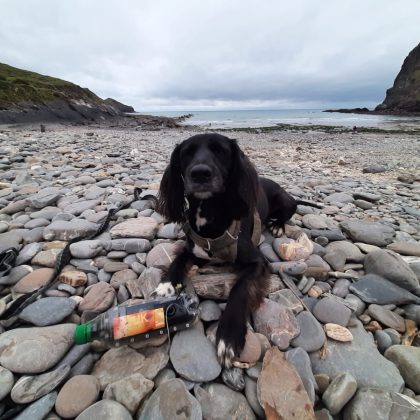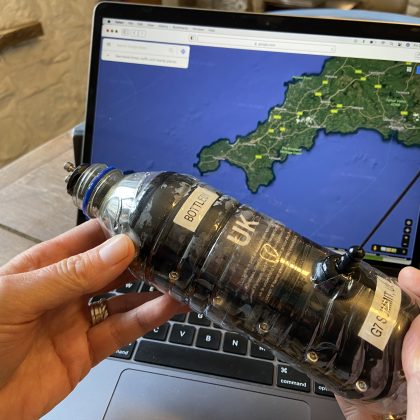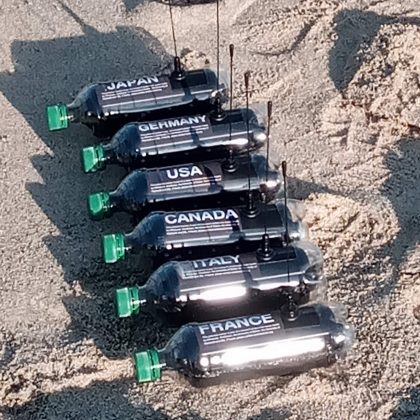Your Questions Answered
What should I do if I find a device?

You are invited to join the experiment! If you spot a pollution tracker that’s washed ashore or become stuck, please email oneless@zsl.org or info@oneocean.org , take a selfie and report it on #ListenToTheOcean. We will then contact you, collect it and re-launch it.
What is the aim of this experiment?
This experiment enables scientists to gather vital, real-time data so that they can build understanding of how an everyday item of plastic litter – in this case, a single-use bottle – moves through the open ocean and the potential risks it poses to marine wildlife along the way.
Right now, we know a lot about where ocean plastic pollution ends up. For example, we know it collects in places such as the Great Pacific Garbage Patch and on the deep seabed. Yet we know far less about how it gets there.
Once we understand its movement in the ocean, we can start to track plastic debris back to where it entered the ocean and pinpoint locations where it may encounter marine wildlife. This understanding is vital given the incredible quantities of plastic that litter our ocean – in 2016 alone, between 18 and 23 million metric tons of plastic was estimated to have entered aquatic ecosystems[1]. Once we have this information, we can better protect vulnerable species and be far more strategic in pinpointing sources of marine plastics.
What’s more, while providing vital data, each tracker also sends a clear message to our leaders that we need to #ListenToTheOcean to prevent climate breakdown.
Has this been done before?
By fitting satellite tracking technology inside an actual plastic water bottle, we can track the true movement of marine pollution for the first time. In the past, traditional tracking floats have been used, but these move and float differently to actual plastic so the insights they provide are less accurate.
This technology was used to track plastic pollution in the Ganges River system in 2019, but it has never been deployed in the open ocean until now.
What are the pollution trackers?

The pollution trackers were designed by conservation technology specialists at Arribada. The design is 100% open source, meaning other researchers can use the same design to understand the movement of plastic marine litter and pollution in their own projects.
Each tracking device contains an internal system consisting of a miniature GPS and satellite transmitter, along with batteries. The system acquires a GPS location every few hours, then transmits the data to satellites 850 kilometres overhead. This means scientists can map the trackers’ movements several times a day.
The trackers have been designed to replicate the flow and movement of a standard 500ml plastic bottle in open water. To do this, Arribada had reduced the tracking technology’s size and weight so it could fit into a bottle, and flow and move in the same way. Each electronic component was specially selected to minimise weight, from the batteries to cabling and screws. Had the bottles been too heavy, the GPS antenna would have been submerged and made it impossible to get a location. Therefore, care was taken to expose the GPS to the sky and keep the bottles as lightweight as possible.
The trackers have also been adapted to cope with rough Atlantic seas and designed to self-right and recover in case a large wave knocks them over, or an ocean swell capsizes them. A tall, thin, 18-centimetre antenna has been fitted to the base to help them transmit in rough weather and their enclosures have been hardened.
What will happen to the pollution trackers?

The trackers have a battery life of two years. If they are washed up on a coastline, efforts will be made to re-deploy them. At their end-of-life, they will be retrieved and recycled where this is possible.
Who is behind this?
This project is run by #OneLess, OneOcean, the University of Plymouth, the University of Exeter, and the Zoological Society of London. The data from this project will feed into a global network of projects, such as the Argo program, that use observing systems to collect huge amounts of vital data about the ocean – from information on weather systems to how climate change influences ocean currents.
The scientific datasets gathered through projects like this fill gaps in our knowledge and enable our leaders to make informed policy decisions on ocean protection and climate change policy – and take more strategic actions.
Why are you adding more plastic to the ocean?
To get accurate data on how plastic moves across the ocean’s surface, it is important that the tracking bottles mimic the behaviour of real plastic pollution – in this case, we chose a single-use plastic bottle. Once the batteries in the tracking devices reach end-of-life, the bottles will be retrieved and recycled if this is possible.
Each bottle weighs 200 grams so, together, all seven bottles weigh 1.4 kilograms. Of the 18 million to 23 million metric tons of plastic estimated to enter aquatic ecosystems in 2016, our seven bottles represent between 0.0000000061% and 0.0000000078% of this total.
What risk do the bottles pose to marine wildlife?
The likelihood of our pollution trackers causing harm to marine wildlife is very low, given their size, shape and very small number. For example, it is very unlikely that a turtle or seabird would attempt to eat a tracker due to its size and shape and, while some species of whale feed on plankton at the ocean’s surface, they filter out larger items, such as bottles. This also is the case for filter feeding fish, such as the iconic basking shark. Wildlife tend to consume smaller items and bags.
However, there always some level of risk of impact for any scientific experiment conducted in the natural world and this must be balanced against the huge value that the data gathered will provide. This data will be used to feed back into conservation science and practice and will help us solve the large-scale problem of ocean plastic pollution.
By providing data on how plastic moves across the ocean’s surface, scientists will be able to better understand where plastic goes and pinpoint locations where it may encounter marine wildlife. This will allow appropriate action to be taken, whether that is clearing up the litter where it ends up or, ideally, preventing it from entering the ocean in the first place.
[1] Borrelle, S.B., Ringma, J., Law, K.L., Monnahan, C.C., Lebreton, L., McGivern, A., Murphy, E., Jambeck, J., Leonard, G.H., Hilleary, M.A., Eriksen, M., Possingham, H.P., De Frond, H., Gerber, L.R., Polidoro, B., Tahir, A., Bernard, M., Mallos, N., Barnes, M. & Rochman, C.M. (2020). Predicted growth in plastic waste exceeds efforts to mitigate plastic pollution. Science 369, Issue 6510, 1515-1518. doi: 10.1126/science.aba3656
